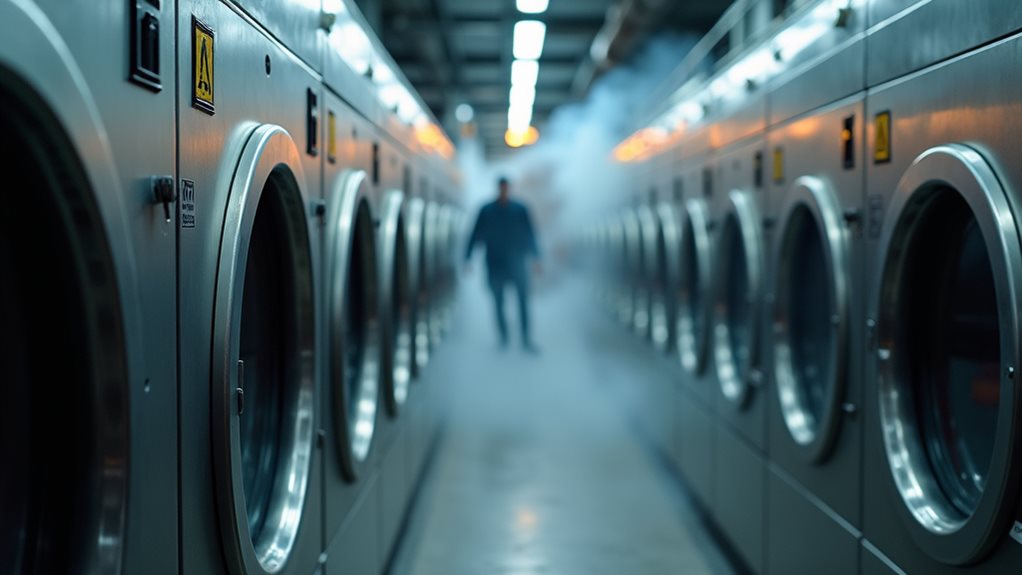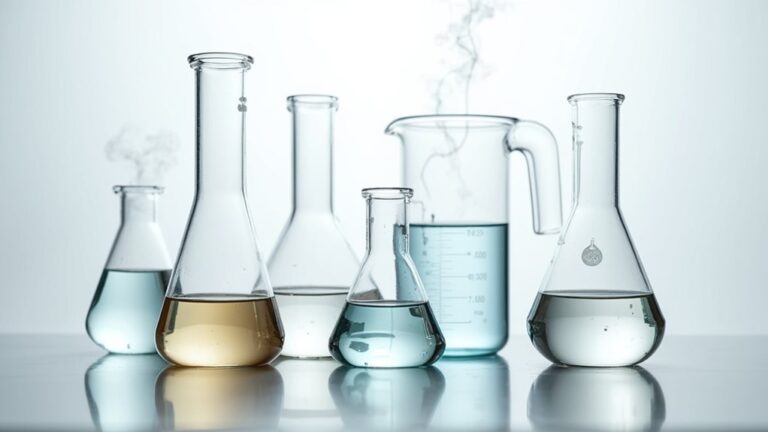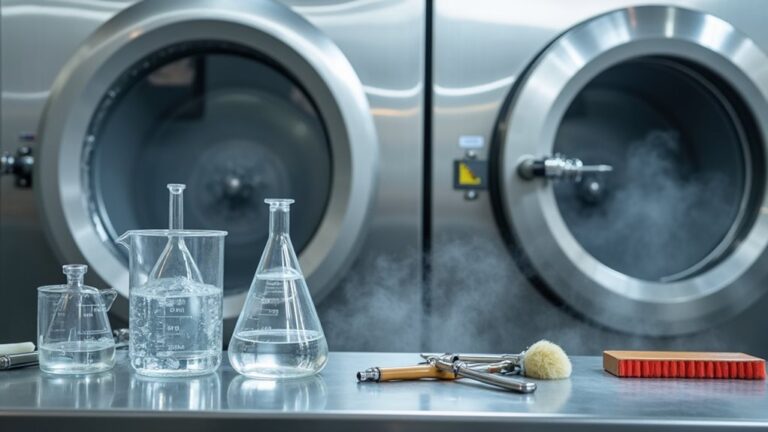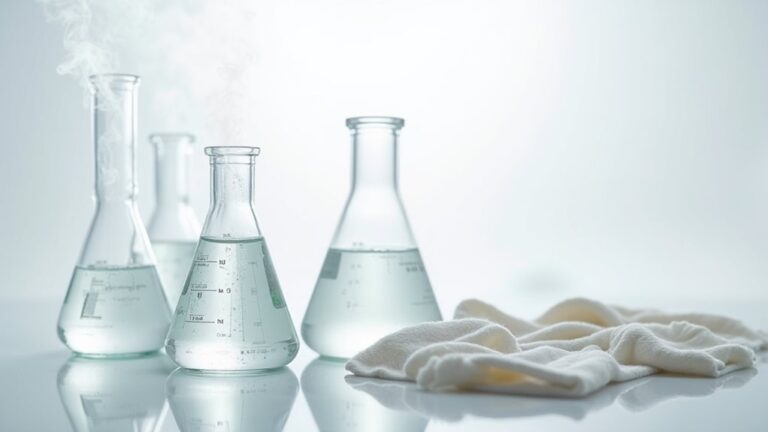Yes, traditional dry cleaning can raise your cancer risk because most cleaners still use perchloroethylene (PERC) and trichloroethylene (TCE), chemicals that federal agencies classify as probable and definitive carcinogens linked to bladder, kidney, and liver cancers. You’re most vulnerable when you bring home freshly cleaned garments that release chemical vapors, though dry cleaning workers face the highest exposure levels with notably increased cancer mortality rates. Fortunately, you can protect yourself by choosing eco-friendly cleaners and learning which safer alternatives actually work.
The Cancer-Causing Chemicals Used in Traditional Dry Cleaning
When I first learned that my favorite blazer might be harboring cancer-causing chemicals, I’ll admit I felt a bit betrayed by an industry I’d trusted for years without question.
Here’s what really shocked me: traditional dry cleaning relies heavily on perchloroethylene (PCE), which the International Agency for Research on Cancer classifies as a probable human carcinogen, and trichloroethylene (TCE), a definitive cancer-causing agent.
These chemicals’ carcinogenic properties aren’t just theoretical concerns—they’re linked to bladder, kidney cancer, and non-Hodgkin lymphoma.
Dry cleaning workers face particularly serious health risks, showing higher rates of cancer mortality from prolonged exposure.
Even the Environmental Protection Agency has stepped in, implementing regulations to phase out these dangerous solvents because the evidence is simply too overwhelming to ignore.
The most concerning part is that PERC residues can remain on your clothes even after the cleaning process, particularly when garments aren’t given adequate time to air out before you wear them.
Health Risks Associated With PERChloroethylene (PERC) Exposure

Although I’d always assumed that the biggest risk from dry cleaning was the occasional missing button, the reality of PERC exposure hit me like a ton of bricks when I started digging into the research.
This perchloroethylene stuff isn’t just some harmless chemical – it’s classified as a probable human carcinogen that can seriously mess with your health.
PERC isn’t some innocent cleaning solution – it’s a probable carcinogen that poses serious health risks to anyone exposed.
Workers in dry cleaning facilities face the highest risks, showing increased rates of bladder, liver, and kidney cancers, plus blood cancers like multiple myeloma.
Even short-term exposure can leave you dizzy and foggy-headed, while long-term contact might damage your reproductive system and immune function.
The environmental regulations are tightening for good reason – this cancer-causing chemical doesn’t mess around.
Beyond cancer risks, PERC exposure has been linked to neurological problems and liver damage, making it particularly dangerous for pregnant women and children who are more vulnerable to these toxic effects.
Scientific Evidence Linking Dry Cleaning Solvents to Cancer

Since diving deeper into the research on dry cleaning chemicals, I’ve discovered that the scientific evidence connecting these solvents to cancer isn’t just theoretical – it’s backed by decades of solid studies that paint a pretty alarming picture.
The International Agency for Research on Cancer classified PCE as a probable carcinogen, while trichloroethylene earned the even scarier designation of definitive human carcinogen.
What really got my attention was learning that dry cleaning workers face considerably higher cancer mortality rates than the general population, with increased risks for bladder cancer, non-Hodgkin lymphoma, and multiple myeloma from exposure to these cleaning chemicals.
The health risks extend beyond workers too – Georgetown University found high PCE levels on fabrics post-cleaning, meaning you’re potentially bringing these solvents home.
While prolonged exposure poses the greatest risks, consumers can reduce their exposure by allowing garments to air out before wearing and choosing facilities that use safer cleaning alternatives.
Who Is Most at Risk From Dry Cleaning Chemical Exposure

Who exactly faces the greatest danger from these cancer-causing dry cleaning chemicals, and why should you care about understanding these risk levels?
Workers involved in the dry cleaning industry shoulder the heaviest burden, breathing in perchloroethylene (PCE) and trichloroethylene (TCE) daily, which creates serious health hazards including increased cancer risks like non-Hodgkin lymphoma.
If you live near these establishments, you’re also vulnerable to chemical exposure through air pollution from vapor emissions – think of it as unwanted neighbors sharing their toxic fumes.
Despite regulatory actions like the EPA’s PCE phase-out, many shops still use these dangerous solvents.
My heart goes out to these hardworking folks who face considerably higher cancer rates than the rest of us, often without fully understanding the risks they’re taking. 💔
Regular consumers can also face exposure through residual chemicals that remain on freshly cleaned garments before they’ve had time to properly air out.
Current Regulations and Bans on Toxic Dry Cleaning Solvents
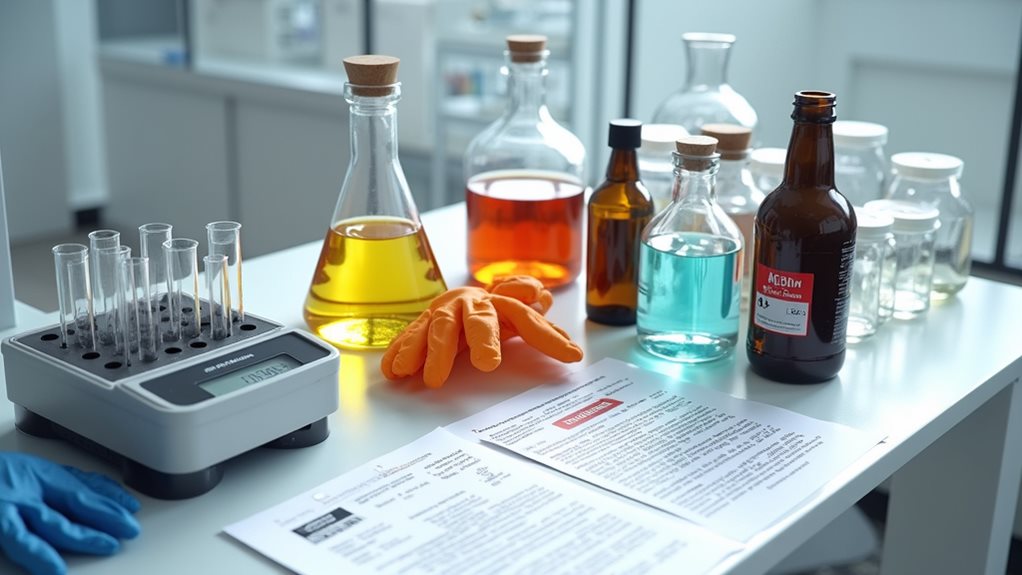
While the dry cleaning industry has operated with minimal oversight for decades, government agencies are finally stepping up to protect both workers and communities from these toxic chemicals, and honestly, it’s about time we saw some real action.
The EPA has implemented an extensive phase out of PERC, that notorious carcinogen we’ve been breathing in our clothes, with a 2034 deadline requiring roughly 30-35% of remaining dry cleaners to ditch this toxic solvent.
California blazed the trail by banning PERC in 2023, while states like New York and Illinois followed suit with their own regulations.
The EPA’s also targeting TCE, another environmental nightmare, showing they’re serious about protecting public health from these cancer-causing chemicals lurking in our neighborhoods.
As the industry transitions away from these harmful solvents, many facilities are adopting safer alternatives like wet cleaning, hydrocarbon solvents, and silicone-based methods that significantly reduce health risks.
Safer Alternatives to Traditional Dry Cleaning Methods
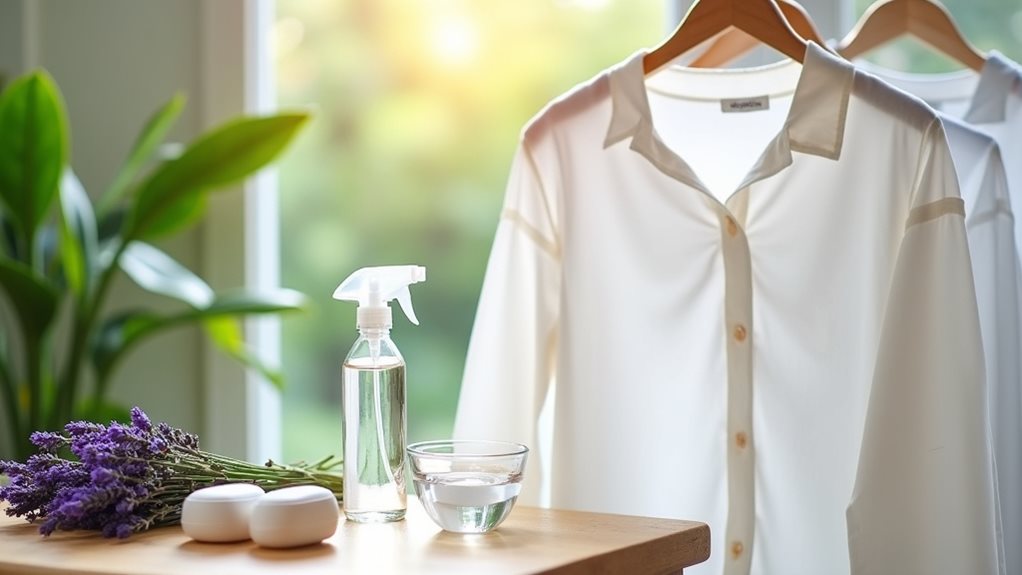
You don’t have to stick with traditional dry cleaning anymore, especially when safer alternatives like water-based cleaning methods, carbon dioxide technology, and silicone-based solutions can protect both your health and your favorite blazer 👔.
I remember feeling relieved when I discovered these options exist, because honestly, who wants to worry about cancer-causing chemicals clinging to their clothes?
These innovative methods clean just as effectively as the old-school solvents, though I’ll admit the change feels a bit like switching from flip phones to smartphones – intimidating at first, but worth every penny for peace of mind.
The shift away from perchloroethylene has accelerated as regulations tighten and more dry cleaners adopt biodegradable cleaning solutions that maintain excellent stain removal capabilities.
Water-Based Cleaning Methods
Several years ago, when I first learned about wet cleaning methods, I honestly thought it sounded too good to be true – how could water-based cleaning possibly match the effectiveness of those powerful chemical solvents?
Turns out, I was pleasantly wrong! These environmentally friendly alternatives use biodegradable detergents and gentle mechanical action to clean your clothes without exposing you to carcinogenic solvents like PERC.
What amazed me most was discovering that wet cleaning works brilliantly on delicate fabrics traditionally requiring harsh chemical exposure.
The health outcomes speak for themselves – you’re protecting both yourself and dry cleaning workers from toxic solvents.
Even regulatory agencies are encouraging this shift, and honestly, knowing you can get spotless clothes while supporting better environmental practices feels like a genuine win-win situation.
Some dry cleaners have also started using petroleum-based alternatives like Stoddard solvent and specialized hydrocarbon solvents, which offer effective cleaning power while being less toxic than traditional chlorinated options.
Carbon Dioxide Technology
When I first heard about carbon dioxide dry cleaning, my immediate reaction was skepticism – how could the same gas we exhale possibly clean my favorite silk blouse better than those industrial-strength chemicals?
But here’s what changed my mind: carbon dioxide technology uses liquid CO2 as a cleaning solvent, creating this brilliant safer alternative that actually works.
Unlike perchloroethylene (PCE) and trichloroethylene (TCE), which are carcinogenic solvents that make me genuinely worried about health effects, CO2 cleaning processes don’t emit volatile organic compounds or leave toxic residue on your clothes.
It’s environmentally friendly, protects workers from harmful exposure, and achieves the same cleaning results without the cancer risk.
Sure, the upfront costs are higher, but you’re literally investing in your health! 🌱
The importance of proper ventilation in traditional dry cleaning facilities highlights just how toxic conventional solvents really are compared to this CO2 technology.
Silicone-Based Solutions
While carbon dioxide technology impressed me with innovation, silicone-based solutions like D5 (decamethylcyclopentasiloxane) have become my go-to recommendation for friends who want safer dry cleaning without breaking the bank.
These cleaning methods are less aggressive than traditional solvents like PCE, considerably reducing health risks for workers and consumers alike.
What I love most is that silicone-based solutions are environmentally friendly and biodegradable, addressing concerns about chemical exposure without sacrificing garment quality.
Unlike conventional methods that leave harmful residues, these solutions evaporate cleanly from your clothes.
The IARC hasn’t classified D5 due to insufficient data, suggesting it’s a safer alternative.
These newer solvents maintain chemical stability while effectively dissolving oils and greases, making them highly effective for professional cleaning applications.
Unfortunately, industry resistance persists because many cleaners resist change despite obvious advantages.
How to Protect Yourself From Dry Cleaning Cancer Risks
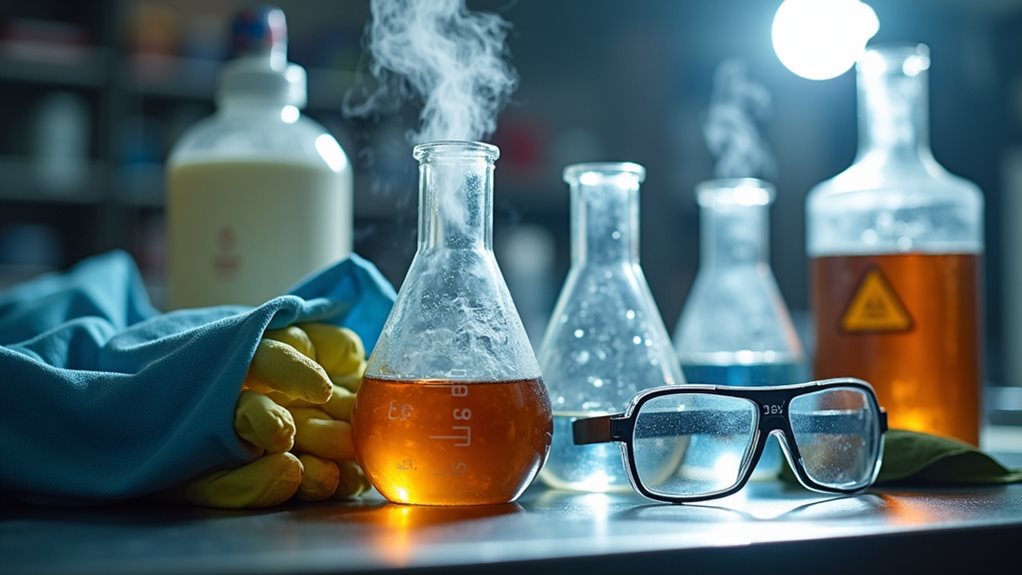
While you can’t completely eliminate cancer risks from dry cleaning, you can greatly reduce your exposure by making smarter choices about where you take your clothes and how you handle them afterward.
I learned this the hard way when my favorite blazer came back from the cleaner smelling so strongly of chemicals that my eyes watered – that’s when I realized I needed to find a dry cleaner who uses safer alternatives like liquid CO2 or wet cleaning methods instead of those harsh solvents like PERC.
The key is being proactive about minimizing your exposure risks, whether that means asking tough questions about cleaning methods, airing out your garments before bringing them inside, or simply washing more items at home than you might think possible.
Look for dry cleaners that have earned certified green status, as these facilities have been verified to use environmentally safe cleaning methods and follow stricter safety protocols.
Choose Safer Alternatives
Although the thought of giving up your trusted dry cleaner might feel like abandoning an old friend, protecting yourself from potential cancer risks doesn’t mean you’ll have to sacrifice crisp, professional-looking clothes.
You’ve got several safer alternatives that’ll keep your wardrobe looking sharp while reducing chemical exposure from traditional solvents like PERC, a known carcinogen.
Here are your best options for healthier garment care:
- Eco-friendly dry cleaners using liquid carbon dioxide or wet cleaning methods instead of toxic solvents
- At-home dry cleaning kits that refresh clothes without harsh chemicals
- Professional wet cleaning services that use water-based, biodegradable detergents
I’ve discovered that many “dry-clean-only” labels are more like suggestions than commandments—gentle handwashing often works wonders, saving both money and health risks! 💡
Minimize Exposure Risks
Even when you can’t completely avoid dry cleaning, you can dramatically reduce your cancer risk by taking smart precautions that I’ve learned through years of trial and error—some admittedly after making rookie mistakes like leaving freshly cleaned suits hanging in my stuffy car for hours! 🤦♀️
The key lies in understanding that those crisp garments continue releasing chemical vapors long after you pick them up, which means your protective strategy needs to focus on minimizing how much of those toxins you actually breathe in.
First, ask your cleaners about their cleaning methods and seek establishments using non-toxic alternatives instead of PERC.
When you store dry-cleaned items, hang them outdoors briefly before bringing them inside, then choose well-ventilated areas away from bedrooms.
Consider investing in air purifiers with VOC filters to improve indoor air quality and capture those lingering volatile organic compounds that threaten your health.

